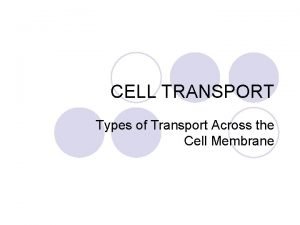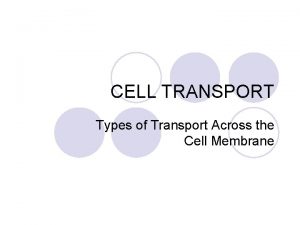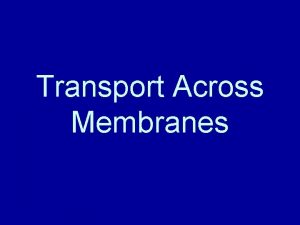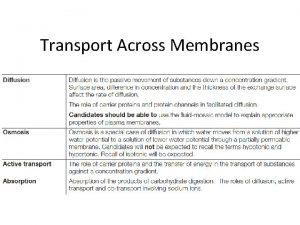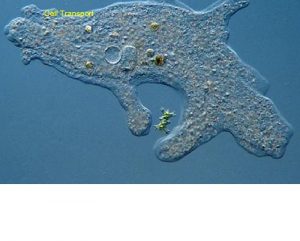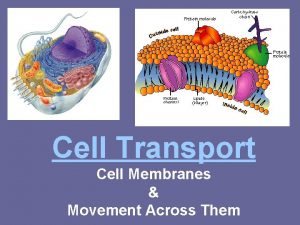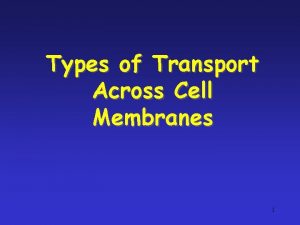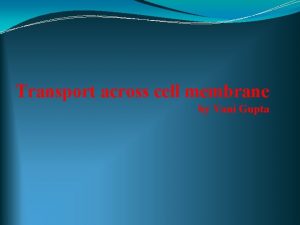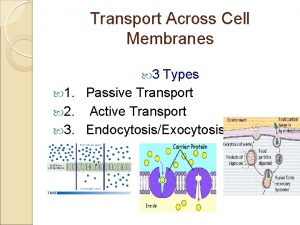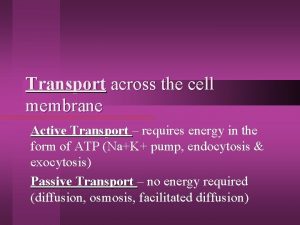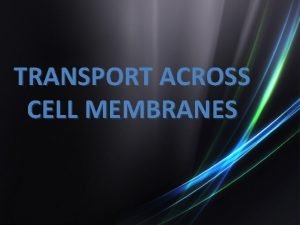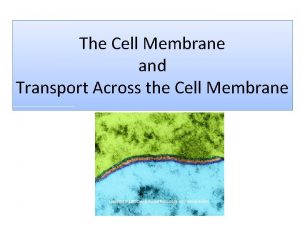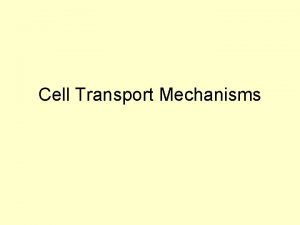CELL TRANSPORT Types of Transport Across the Cell




























- Slides: 28

CELL TRANSPORT Types of Transport Across the Cell Membrane

Smelly Balloons Draw and fill out in your science notebook. Balloon Color Blue Red Pink Yellow Scent

l Answer in your science notebook. l How do “smells” get out of the balloon?

Essential Questions l How do cells maintain homeostasis (makes a cell stable and healthy)? l How are materials transported in and out of a cell? l Why is important to regulate what moves in and out of a cell?

Semipermeable Membrane l The cell membrane allows some materials in and out! l https: //www. youtube. com/watch? v=Ptmlvt ei 8 hw

Simple Diffusion l. Requires NO energy ¡Molecules move from area of HIGH to LOW concentration

Diffusion is a PASSIVE process which means no energy is used to make the molecules move, they have a natural KINETIC ENERGY

Diffusion of Lipids

Diffusion Through a Membrane l Solute moves DOWN the concentration gradient. (HIGH to LOW)

Osmosis l Diffusion of water across a membrane ¡ Moves from HIGH water concentration to LOW water concentration l Water is attracted to solutes (like salt) so it will also travel to areas of low solute concentration to high solute concentration.

Diffusion of Water Across A Membrane l High water concentration l Low solute concentration Low water concentration High solute concentration

Cells in Solutions l Isotonic ¡A solution whose solute concentration is the same as the solute concentration inside the cell. l Hypotonic ¡A solution whose solute concentration is lower than the solute concentration inside a cell l Hypertonic ¡A solution whose solute concentration is higher than the solute concentration inside a cell.

Cell in Isotonic Solution l What is the direction of water movement? The solute and water concentrations are the same inside and outside the cell. ¡ The cell is at EQUILIBRIUM ¡ Water will flow in both directions outside and inside the cell.

Cell in Hypotonic Solution l What is the direction of water movement? ¡ The water is going INSIDE the cell. l Water is attracted to the solute inside the cell. The solute concentration is greater inside the cell than outside, therefore water will flow into the cell.

Cell in Hypertonic Solution l What is the direction of water movement? ¡ The water is GOING OUT of the cell. The solute concentration is greater outside the cell, therefore water will flow outside the cell.

Cells in Solutions

Cells in Solutions l Isotonic solution l l No net movement of water. EQUAL amounts leaving and entering hypotonic solution CYTOLYSIS hypertonic solution PLASMOLYSIS

Cells in Solutions l Cytolysis cytolysis in elodea. ¡The destruction of a cell. l. Cells swell and burst l Plasmolysis in elodea. ¡The shrinking of a cell. l. Cells shrink and shrivel Normal elodea plant cell

Cytolysis & Plasmolysis l Cytolysis Plasmolysis

Osmosis in Red Blood Cells l Isotonic Hypertonic

Three Forms of Transport Across the Membrane l Passive Transport Active Transport

Passive Transport: Simple Diffusion l Simple Diffusion ¡ Doesn’t require energy ¡ Moves high to low concentration l Example: Oxygen or water diffusing into a cell and carbon dioxide diffusing out.

Passive Transport: Facilitated Diffusion l Facilitated Diffusion ¡ Does not require energy ¡ Uses transport proteins to move high to low concentration l Examples: Glucose or amino acids moving from blood into a cell.

Proteins are Crucial to Membrane Function

Facilitated Diffusion Molecules will randomly move through the pores in Channel Proteins.

Types of Transport Proteins l Channel proteins are embedded in the cell membrane & have a pore for materials to cross l Carrier proteins can change shape to move material from one side of the membrane to the other

Facilitated Diffusion l Some carrier proteins do not extend through the membrane. ¡ They bond and drag molecules through the lipid bilayer and release them on the opposite side.

Active Transport l Active Transport ¡ Requires energy or ATP l Moves materials from LOW to HIGH concentration • AGAINST concentration gradient
 Sodium potasium pump
Sodium potasium pump Primary active transport and secondary active transport
Primary active transport and secondary active transport Now answer the following questions
Now answer the following questions Active transport vs passive transport venn diagram
Active transport vs passive transport venn diagram Unlike passive transport active transport requires
Unlike passive transport active transport requires Primary active transport vs secondary active transport
Primary active transport vs secondary active transport Bioflix activity membrane transport active transport
Bioflix activity membrane transport active transport Active transport image
Active transport image Selectively permeable definition biology
Selectively permeable definition biology Hát kết hợp bộ gõ cơ thể
Hát kết hợp bộ gõ cơ thể Slidetodoc
Slidetodoc Bổ thể
Bổ thể Tỉ lệ cơ thể trẻ em
Tỉ lệ cơ thể trẻ em Gấu đi như thế nào
Gấu đi như thế nào Chụp tư thế worms-breton
Chụp tư thế worms-breton Hát lên người ơi
Hát lên người ơi Các môn thể thao bắt đầu bằng từ đua
Các môn thể thao bắt đầu bằng từ đua Thế nào là hệ số cao nhất
Thế nào là hệ số cao nhất Các châu lục và đại dương trên thế giới
Các châu lục và đại dương trên thế giới Công thức tính thế năng
Công thức tính thế năng Trời xanh đây là của chúng ta thể thơ
Trời xanh đây là của chúng ta thể thơ Mật thư tọa độ 5x5
Mật thư tọa độ 5x5 Làm thế nào để 102-1=99
Làm thế nào để 102-1=99 độ dài liên kết
độ dài liên kết Các châu lục và đại dương trên thế giới
Các châu lục và đại dương trên thế giới Thể thơ truyền thống
Thể thơ truyền thống Quá trình desamine hóa có thể tạo ra
Quá trình desamine hóa có thể tạo ra Một số thể thơ truyền thống
Một số thể thơ truyền thống Cái miệng bé xinh thế chỉ nói điều hay thôi
Cái miệng bé xinh thế chỉ nói điều hay thôi





























